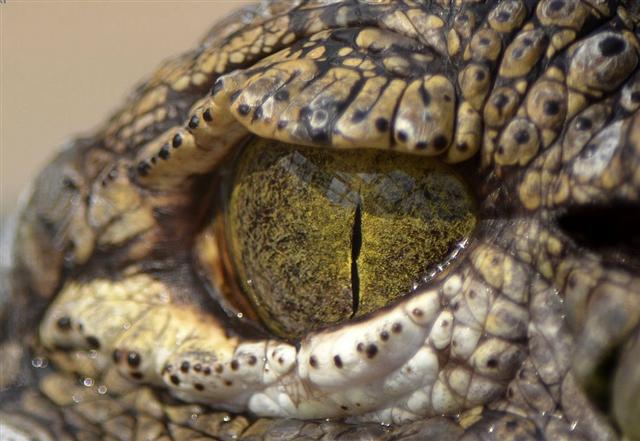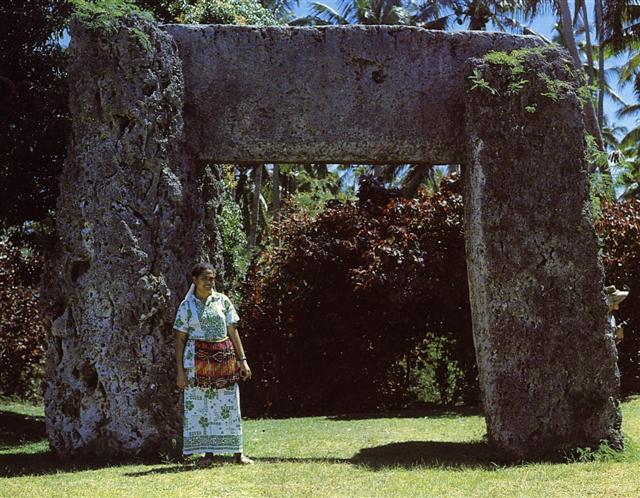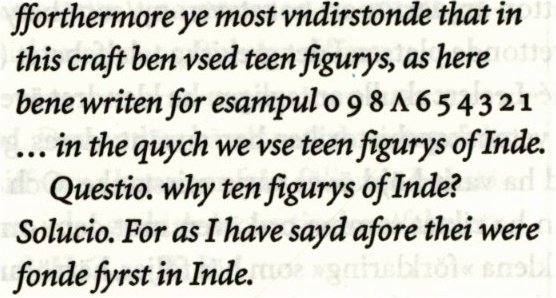|
ADDENDA
10a. It could be added that the eye of a crocodile (at the surface of the water) might have inspired the design with an eye divided vertically:  The Chinese list has the star which the Polynesians said was in the middle (Ana-roto, Spica) at its beginning and as a key word they had the suggestion 'Crocodile'. The pharaoh was evidently in the middle when he was inside the palace chapel, and the idea seems to have been that he should be given permission to carry on: ... When he reappears he is clothed as in the Narmer palette, wearing the kilt with Hathor belt and bull's tail attatched. In his right hand he holds the flail scepter and in his left, instead of the usual crook of the Good Shepherd, an object resembling a small scroll, called the Will, the House Document, or Secret of the Two Partners, which he exhibits in triumph, proclaiming to all in attendance that it was given him by his dead father Osiris, in the presence of the earth-god Geb. 'I have run', he cries, 'holding the Secret of the Two Partners, the Will that my father has given me before Geb. I have passed through the land and touched the four sides of it. I traverse it as I desire.' ...
Inside the palace chapel it was dark - this we can deduce from the fact that the wood of the inscribed tablet was ebenholz. Furthermore, the headgear of pharaoh was in touch with a hole through the wood leading to the opposite side. Through holes located at the horizon the winds of change were arriving. The left (back) side was in the shadows in contrast to the front side:
As a kind of windfall from my recent revision of the H tablet we have been given the tables below: ... In other words, the ancient Druidic religion based on the oak-cult will be swept away by Christianity and the door - the god Llyr - will languish forgotten in the Castle of Arianrhod, the Corona Borealis. This helps us to understand the relationship at Rome of Janus and the White Goddess Cardea who is ... the Goddess of Hinges who came to Rome from Alba Longa. She was the hinge on which the year swung - the ancient Latin, not the Etruscan year - and her importance as such is recorded in the Latin adjective cardinalis - as we say in English 'of cardinal importance - which was also applied to the four main winds; for winds were considered as under the sole direction of the Great Goddess until Classical times. As Cardea she ruled over the Celestial Hinge at the back of the North Wind around which, as Varro explains in his De Re Rustica, the mill-stone of the Universe revolves. This conception appears most plainly in the Norse Edda, where the giantesses Fenja and Menja, who turn the monstrous mill-stone Grotte in the cold polar night, stand for the White Goddess in her complementary moods of creation and destruction. Elsewhere in Norse mythology the Goddess is nine-fold: the nine giantesses who were joint-mothers of the hero Rig, alias Heimdall, the inventor of the Norse social system, similarly turned the cosmic mill ... Cfr the sign of wind (matagi) in front at glyph number 136 (presumably alluding to day 136, May 16, when the Sun rose together with Alcyone in the Pleiades):
Here we can read that in July 1 - the day after Sirius - there were 3 'eyes' (mata etoru) in the past. In front, in contrast, was a sign of general potency (as I can recall from what Barthel has suggested). Clearly it is similar to the sign that was used at Ca6-22 for the night of Ohiro (Mercury):
And then the same glyph arrives once again at day 80 + 124 = 204, i.e. 22 days later in July 23 (181 + 23 = 204):
July 23 is the day after July 22 which date could be perceived as a sign for the end of a cycle as meassured out by π (because July 22 could be written 22 / 7).
... About Carmenta we know from the historian Dionysus Periergetis that she gave orcales to Hercules and lived to the age of 110 years. 110 was a canonical number, the ideal age which every Egyptian wished to reach and the age at which, for example, the patriarch Joseph died. The 110 years were made up of twenty-two Etruscan lustra of five years each; and 110 years composed the 'cycle' taken over from the Etruscans by the Romans. At the end of each cycle they corrected irregularities in the solar calendar by intercalation and held Secular Games. The secret sense of 22 - sacred numbers were never chosen haphazardly - is that it is the measure of the circumference of the circle when the diameter is 7. This proportion, now known as pi, is no longer a religious secret; and is used today only as a rule-of-thumb formula, the real mathematical value of pi being a decimal figure which nobody has yet been able work out because it goes on without ever ending, as 22 / 7 does, in a neat recurring sequence. Seven lustra add up to thirty-five years, and thirty-five at Rome was the age at which a man was held to reach his prime and might be elected Consul ...
The star names The End (Al Tarf) and Bright Fire could allude to 413 (= 14 * 29½) respectively to 414 ('one more'). We should notice that the triplet of 'walking sky' glyphs are arriving 3 days later in both instances - which suggests the subject matter is the night sky (ragi). 360 / 2 = 6 * 29½ + 3.
|
||||||||||||||||||||||||||||||||||||||||||||||||||||||||||||||||||||||||||||||||||||||||||||||||||
.jpg)










